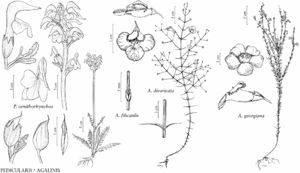Agalinis aphylla
New Fl. 2: 65. 1837.
Stems simple or branched, 40–140 cm; branches stiffly ascending, quadrangular, siliceous-ridged, glabrate or scabridulous. Leaves appressed or slightly divergent; blade subulate to narrowly triangular, 0.5–3 x 0.2–1 mm, margins entire, siliceous, adaxial surface scabridulous; axillary fascicles absent. Inflorescences racemes, sometimes with 1–3 mm, floriferous branches, flowers 1 or 2 per node; bracts shorter than or both shorter and longer than, sometimes equal to, pedicels. Pedicels ascending, 1–3(–4) mm, glabrous. Flowers: calyx hemispheric, tube (1.5–)2–3.5 mm, glabrous, lobes subulate, 0.2–0.6 mm; corolla pale to dark pink, with 2 yellow lines and dark pink spots in abaxial throat, 12–20 mm, throat pilose externally and villous within across bases and sinus of adaxial lobes, lobes: abaxial spreading, adaxial reflexed-spreading, 4–6 mm, glabrous externally; proximal anthers parallel to filaments, distal perpendicular to filaments, pollen sacs (1.6–)2–3 mm; style exserted, 7–9 mm. Capsules globular, 3–5.5 mm. Seeds yellowish tan, 0.7–1.4 mm. 2n = 26.
Phenology: Flowering early Sep–mid Oct.
Habitat: Bogs, wet flatwoods, hydric savannas, seepage slopes.
Elevation: 0–100 m.
Distribution
Ala., Fla., Ga., La., Miss., N.C., S.C.
Discussion
Plants of Agalinis aphylla grow in more mesic portions of wetlands and rarely grow in the deep, saturated, mucky soil where A. harperi and A. linifolia are found. The ecotone between these communities is marked by the distribution of A. aphylla, which often forms a distinctive border between inundated and saturated to mesic soil. The pedicels, buds, and capsules of A. aphylla dry reddish brown to black and contrast markedly with the much paler greenish tan stems and branches. Corollas dry brownish pink, and styles are often pilose.
Selected References
None.
